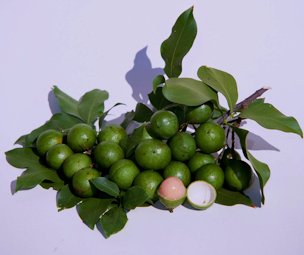From Fairchild
Tropical Botanic Garden
by Noris Ledesma Curator of Tropical Fruit
Spanish Lime
As published in the Miami Herald
Despite the Spanish limes common name, they are not limes at all
and are actually more closely related to lychees and longans. The
Spanish lime (Melicoccus bijugatus) is native to Colombia, Venezuela, West Indies and the Bahamas. It
thrives in the warmer parts of Florida with trees growing in Palm
Beach and most of South Florida. It seems to fruit most prolifically in
Key West.

Beneath
its green skin is a large seed coated in a peach colored flesh, which
tastes a bit like a lime. The most common way of eating Spanish limes
is to remove the skin and eat the pulp from the seed. They are also
made into jams, jellies, pies and drinks. The juice is often added to
mixed fruit juices. In Colombia, the peeled fruit are often soaked in
rum and sugar to make a delicious beverage. If roasted, the seeds are
edible and can be eaten like chestnuts. Spanish lime is a good source
of iron, as well as fiber, calcium, Vitamin A, phosphorus and niacin.
Growing Spanish Lime in South Florida:
In
Florida, the Spanish lime is grown as a fruit tree or as an attractive
shade tree. The tree is slow growing and has a rounded, spreading
canopy. Spanish limes make a good choice for South Florida as they are
well adapted to our poor soils and will do well in salty conditions.
Trees are not freeze tolerant so cold protection must be provided for
young trees by covering the entire tree with a blanket or with a large
cardboard box during freezing temperatures.
Fertilizing:
Young trees do best with regular applications of water, but mature
trees can do quite nicely with no supplemental irrigation. A granular
fertilizer like an 8-3-9 or similar formulation should be applied
in March, June and August. The granular fertilizer should be spread
lightly below the drip line. A foliar minor element spray and iron
drench should be done in June and August to improve the growth of the
tree.
Pruning: Young trees should not be pruned their first
year but should be allowed to grow. After 2 years shoud be start
pruning to keep the tree approximately 7 feet tall. Without pruning,
Spanish limes can reach heights of 40 feet or more.
Spanish
limes typically bloom in the spring, with fruit production
starting shortly after and continuing until fall depending on the
cultivar.
The fruit should be harvested when fully ripe. Ripeness is sometimes
difficult to determine as the fruit undergo no real color change
remaining a dark green. Ripeness is determined by fruit size and if
necessary, flavor.

The Curators of Fairchild Tropical Botanic Garden’s Tropical Fruit
Program have collected Spanish limes in Puerto Rico, Jamaica, Costa
Rica, Nicaragua and the backyards of Florida in order to make a
collection of superior cultivars. Good choices for home growers are
‘Montgomery’, 'Ponce’, ‘Sosa’, and ‘Jose Pabon’. These trees are now
easily found in local nurseries. Spanish limes can be female or male so
make sure you buy a female tree that has been grafted or air layered as
male trees will not produce fruit.
Back to
Mamoncillo Page
|
|

